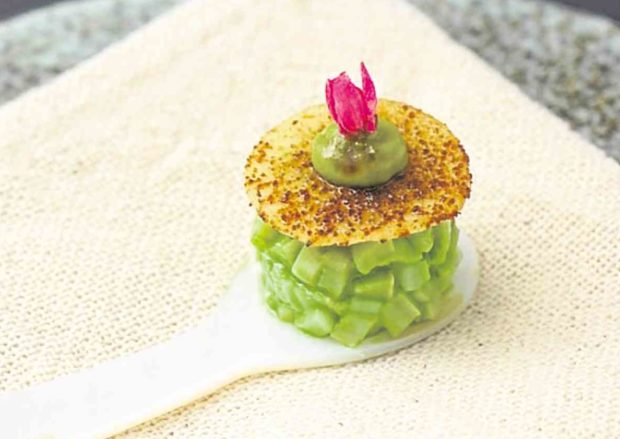The canapés were mostly too small for us to discern the ingredients. But you could read that in the menu, since the in thing now is to list ingredients, then let the diner taste how the chefs put them together.
Two chefs worked in one kitchen that day. Host restaurant was the Gallery by Chele Gonzalez at The Fort, and visiting was Julien Royer of Odette in Singapore.
It was the fourth in the Serie Kulynarya 2018 calendar, a series of collaborations with Gonzalez and outstanding chefs who are given, according to the promotional material, “the opportunity to share their own knowledge and wisdom and discover the wonders of the Filipino kitchen.”
Of course, some diners may partake of this rare feast, taste the food of the two-Michelin star Odette, for instance, without having to fly to Singapore.
Royer’s gaufette or potato crisps shaped like waffles held smoked cream cheese, trout eggs and dill powder, blended together in one bite.
His layers, consisting of plankton and razor clams and seasoned with soya salt, were an artwork for the eyes and tongue.

Black blobs
Gonzalez had two black blobs of meringue, colored and flavored with one of the most unique flavors, adobong pusit ink. His other canapé that didn’t look like one was a soup of ube chawan mushi with suwahe (black shrimps), really small ones that he said are now in season, with a tinapa (smoked fish) dashi.
His use of Filipino names for his ingredients is not surprising to those who know of his obsession with local produce.
After the canapés, tasting bowls and plates accompanied by corresponding wines came one after the other, leaving hardly enough time for diners to sit back and mull over what they just tasted.
Gonzalez did a ceviche of scallops in tiger milk, the Peruvian leche tigre that uses citrus and spice to cure seafood. The scallops, he said, had to be cooked a bit so as to remain whole. Then, a bit of cashew to complete the flavors.
From Royer was a light green gelatin form that hid a mix of shredded mud crab meat, flavored with Nashi or Asian pear and wasabi oil. The chef had the structure sliced, so as to get all the flavors and textures in a bite.
It was a 2017 Riesling from Pikes, Hills and Valleys of Clare Valley, Australia, that was served with the food, refreshing our palate for the next courses.
Gonzalez’s slice of banana heart, cooked and served with coconut milk and strewn with peanuts, tasted almost like the puso ng saging in kare-kare sauce. But most diners at the table compared the heart to artichoke.
The orange sauce of Royer’s next dish, blue river prawns, highlighted the best part of the main ingredient, its big head, where all the orange fat resides.
Carrot slices emphasized the orange color again, contrasting with nasturtium leaves, but the chef placed an unfamiliar ingredient on the table—tonka beans—which made us Google this rare, expensive ingredient. Even with its hard shell, the beans emitted an aroma mix of vanilla, tobacco and chocolate.
Asian cooking
The Gris Blanc Rose of Gerard Bertrand 2017 (Languedoc) is supposed to go well with Asian cooking, and it did, especially with the banana heart coconut milk sauce and the river prawn orange sauce.
A change of wine to a red—Pikes Assemblage GSM 2015, Australia—ushered in two dishes.
Gonzalez reprised his Gallery Bana-lu, lobster with eggplant and okra, whose seeds swam in the broth.
On the kitchen table sat the prepared Pithivers Grand Cuisine with rosemary leaves stuck on top. This is Royer’s recreation of the Christmas pie that his grandmother, Odette, used to make.
The restaurant is named after her, a tribute to her cooking and the love she put into it, said Royer.
For that lunch, Royer sliced each pithiver, giving a quarter portion to each guest, each slice revealing the layers which earned the name “grand cuisine”—poulard de Bresse (Bresse chicken) and foie gras.
And then a plate of black truffles was placed on the table, which Royer and his other chefs grated for each guest as a finishing touch. With the wine, it was a dish to dream about, including that one Bresse chicken leg that completed it.
After the crab gelatin, there appeared a white one called Yuzu T’Art by Royer. Yuzu gave that citrus flavor, and the shiso leaves strewn on top enhanced that Japanese touch. Underneath was sablé Breton (cookie) and a touch of basil.
Gonzalez redesigned his coconuts with a fruit tart on the side and ice cream tasting of kaffir lime.
The citrus notes of both desserts were enhanced by a fruity sweet wine, a Dr. Loosen Bernkasteler Lay Kabinett Riesling 2015 (Mosel).
From the high cuisine that Serie Kulynaria at the Gallery function room served for lunch, Gonzalez said it was time for the Singapore-based chefs to experience a simple Filipino repast with the Gallery staff.
At the main dining hall, tables were put together, banana leaves covered the top, and the set-up spelled “boodle fight.”
After cooking and plating the precise haute cuisine, it was time to let the chefs from Singapore taste real Filipino food served in a casual manner, with or without utensils.
E-mail the author at pinoyfood04@yahoo.com